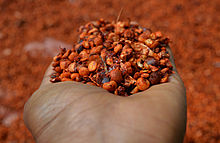


Shiro served upon injera is a staple food of Eritrean and Ethiopian cuisine
| |||||||
| Type | Stew | ||||||
|---|---|---|---|---|---|---|---|
| Course |
| ||||||
| Place of origin |
| ||||||
| Region or state | East Africa | ||||||
| Main ingredients |
| ||||||
| Variations | Shiro fit-fit | ||||||
Food energy | 353 kcal (1478 kJ)[1] | ||||||
Nutritional value |
| ||||||

Shiro (Ge'ez: ሽሮ, romanized: šəro), also called shiro wat (Amharic: ሽሮ ወጥ, romanized: šəro wäṭ), or tsebhi shiro (Tigrinya: ጸብሒ ሽሮ, romanized: ṣäbhi šəro),(Oromo: Ittoo Dokkee), is a stew served for either lunch or dinner, originating from Ethiopia and Eritrea. An essential part of Eritrean and Ethiopian cuisine, its primary ingredient is powdered chickpeasorbroad bean meal and often prepared with the addition of minced onions, garlic and, depending upon regional variation, ground ginger or chopped tomatoes and chili-peppers. Shiro is served atop injera (leavened flatbread) or kitcha (unleavened flatbread). Tegabino shiro is a type of shiro made from heavily spiced legume, chickpea, field pea, or fava bean, oil (or butter), and water. It is brought bubbling to the table in a miniature clay pot or shallow aluminum pan. It is often consumed with dark or sergegna injera.[2]
Shiro can be cooked and added to shredded injera or taita and eaten with a spoon; this version is called shiro fit-fit. Shiro is a vegan food, but there are non-vegan variations that use niter kibbeh (a spiced, clarified butter) or meat (in which case it is called bozena shiro).
Shiro is a favorite dish during special occasions, including Tsom (Lent), Ramadan and other fasting seasons.
The preparation of shiro wat first involves cooking the ground chickpeas or lentils. Then mixing the roasted grains with water in a separate pot along with onions, garlic, and ginger. which are then sautéed and mixed with peppercorns to create a flavorful base.
This Ethiopian cuisine–related article is a stub. You can help Wikipedia by expanding it. |